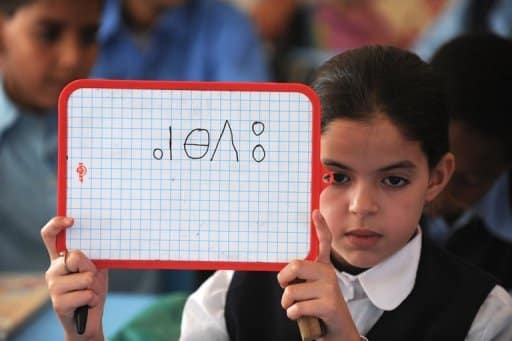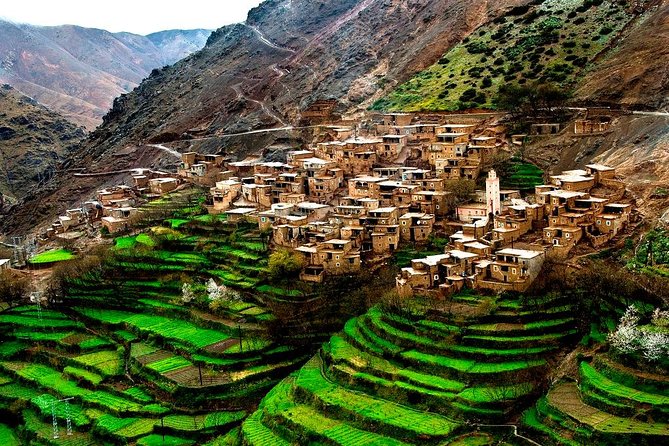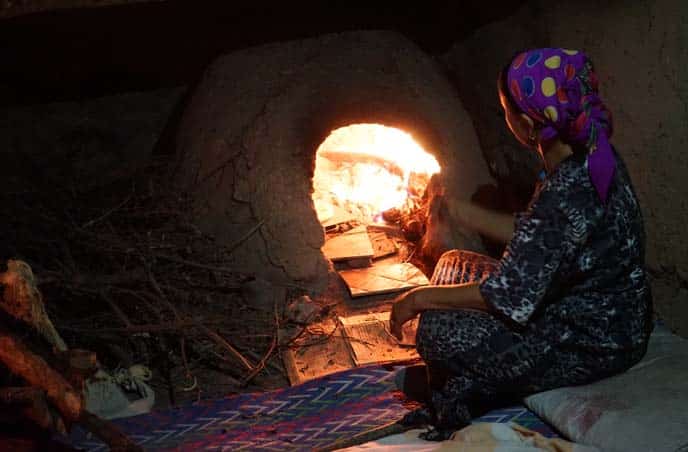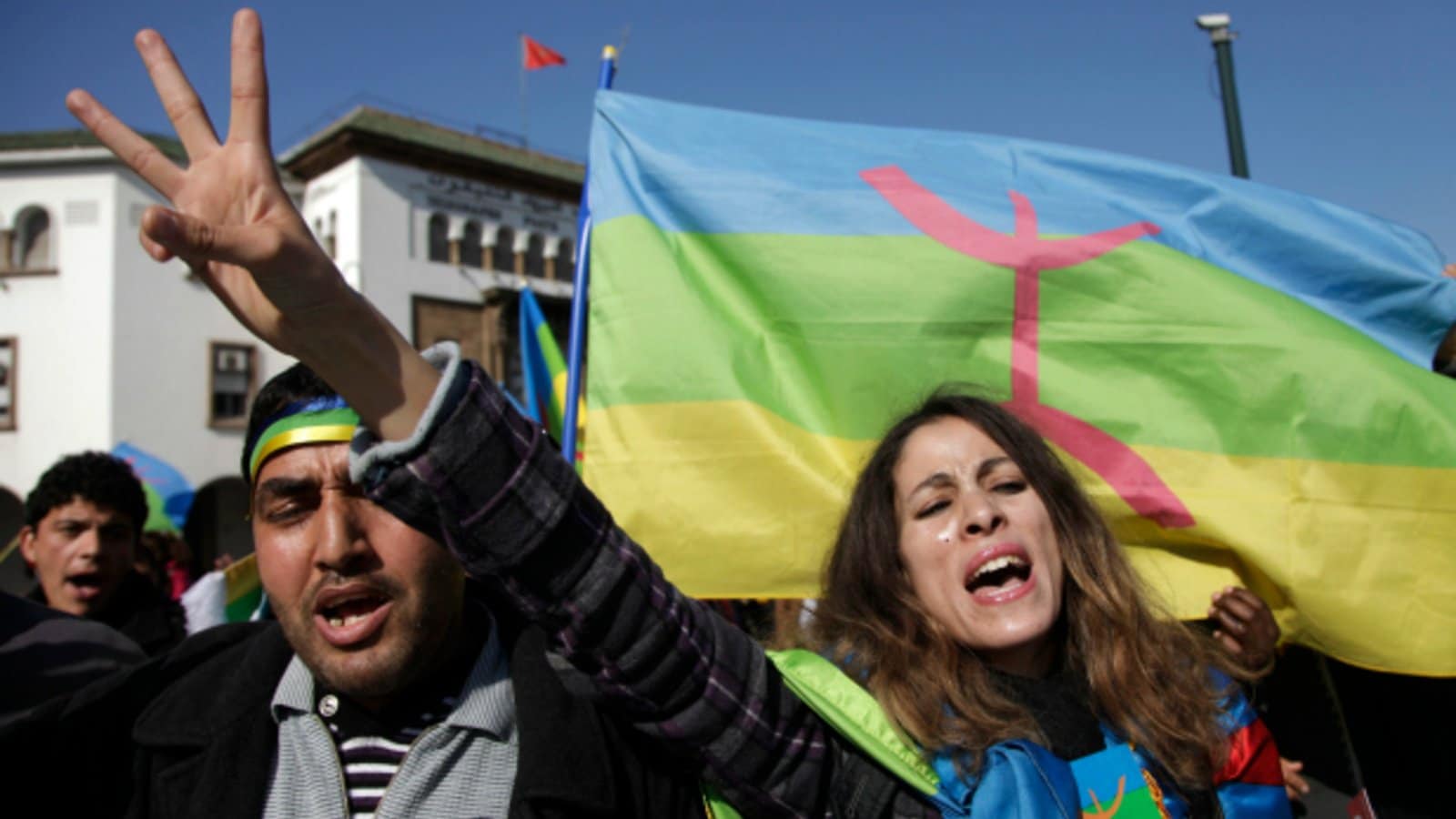[dropcap]T[/dropcap]he Amazigh flag is comprised of three vertical bands equal in width each of a different color, and in the center a single letter of Tifinagh, the yaz. Every component of this flag is symbolic of a quintessential aspect of Amazigh culture: the blue of the first band is representative of the Mediterranean sea, also known as the Northern border of Tamazgha (Amazigh land); the subsequent band green, indicating the environment and the fertility of land; the final band yellow, denoting the sands of the Sahara upon which the Twaregs reside. The final element, a single character, contains two meanings: the letter itself translates to “free man” and is juxtaposed with its assertive color of red, the color of struggle, resistance, and blood (sacrifice).
[ads1]
Characteristics of Amazigh identity
Similar to the way in which Amazigh carpets tell a story, the Amazigh flag speaks to the most sacred characteristics of Amazigh identity (nature, land, and community) and reflects the ostensibly perpetual struggle to maintain them. Through focusing on this struggle using a linguistic lens, the fluidity of Moroccan identity will be called into question; however, in order the analyze the problematic qualities of Amazighness, we must understand the nature of language with relation to culture, history, religion, and ethnic identity, followed by a more chronological discussion of the evolution of Tamazight before, during, and after the French colonial occupation of Morocco.
A language, especially one that is exclusive to a minority group concentrated predominately in a defined area, functions not only as a means of communication, but as a signifier of identity, culture practices, customs, beliefs, and heritage. According to Herder, a group’s language is considered to be
“the ‘treasury of the thought of an entire people’ and the mirror of its history, its deeds, joys, and sorrows”.
What complicates the notion of a single language representing the Amazigh people is the tolerance of this group, which permitted linguistic adoptions of features of Arabic and French, allowing these three languages to build upon one and other and co-exist. Although approximately 40% of the Moroccan population speak Tamazight, it is obvious that its use is decreasing dramatically despite recent reforms. The fear that Tamazight will ultimately be forgotten is a valid one in Morocco, as Arab and French colonizers have been exercising linguistic imperialism over the Imazighen for centuries.
Herder equates loss of language to loss of identity, but this statement is not as direct as it might appear, for inability to speak the language of one’s ancestors or relatives does not necessarily suggest that one will stop identifying oneself as a product of that culture, as Amazigh.
But, according to certain anthropologists:
“the most prominent index to ethnicity is linguistic. People define themselves as Imazighen once they speak the Amazigh language. This is not surprising since language does in general constitute a very strong factor in group identity.”
By contrast,
“the supra-tribal, collective nature of Berber identity,”
enables
“many Imazighen [to] view themselves as Arab-Muslim-Imazighen.”
Evidently, the issue of speaking Tamazight plays a major role in determining whether or not one is deserving of identifying oneself as definitively Amazigh; nevertheless, the tension between this absolute indicator of Amazighness, or mono-nationalistic perspective, and the all-encompassing tendency of Amazigh culture challenges the conventional definition of identity all together. If language is not the source or motivation of identity for the Imazighen, then what is?
Revisiting the symbolism of the Amazigh flag, it appears as though
“the primary factor in determining identity is not language, per se, but land, around which society is organized.”

Teaching Tamazight
Then, if Amazigh identity is connected to land or territory, the systematic denial of the Imazighen as a valid people with a concrete identity with regard to the agendas of both the Arab and French colonial projects is clear. Before a more in-depth discussion of the adverse effects of the French Protectorate on the Imazighen and their language, a brief examination of the Arab occupation of North Africa with respect to religion is crucial in understanding the antagonism between Tamazight and Arabic, then French.
Even though,
“The greatest impediments for the recognition of Amazigh as an official language in Morocco and Algeria have more to do with an identity conflict than with Islam as a religion,”
the inherent qualities of Islam relating to the Arabic language have resulted in the degradation of Tamazight to an inferior language.
Arab denial
The Arabization movement of early Muslim conquerors in North Africa purported the notion of
“Arabic as the most eloquent language,”
for it is the language in which Allah passed the words of the Holy Qur’an to the Prophet Mohammed, emphasizing the fact that other languages used for Islamic purposes are illegitimate. Additionally, we find a
“historical dimension [of the existence of the pre-Islam Imazighen which] constitutes a direct challenge to the precepts of Islam, which stipulate that the history of any Muslim begins with Islam; before Islam was the period of ignorance and savagery.”
Therefore, the istislam (or submission) of the Imazighen to Muslim colonizing forces supported the
“seemingly natural superiority conferred on the Arabic language, the language through which God’s word was transmitted and subsequently interpreted by the doctors of the holy law.”
[ads1]
French Protectorate denial
However, during the period of French colonization, the Arabic language’s immediate tie to Islam became a source of friction that certainly affected the position of the Imazighen and led to even greater contention between the three groups.
Of course, the basis of the French colonial occupation was dictated by France’s classic civilizing mission:
“the Berbers are depicted as semi-savage outsiders requiring a civilizing hand.”
Initially, the French committed a grave misjudgment, assuming that the Imazighen would be their potential allies throughout the French occupation, for the Amazigh
only
“seemed superficially Islamized, [and] ancestrally related to Europeans,”
and that they
“would eventually assimilate to French civilization or law as opposed to Arab.”
Undoubtedly, it was
“the early Amazigh writers [who] were among the most ardent opponents of French colonialism,”
due to their close ties with their land and environment. An infringement by the French upon these core Amazigh values would not be tolerated, as evidenced in the idea of bled al-makhzen and bled as-siba. Bled al-makhzen connotes the Moroccan government’s land, and therefore that of the French as the Makhzen were considered to be but valets of the colonizers. Concurrently, bled as-siba indicates Amazigh land. The French employed techniques of management of difference and language planning to create inequality among the Amazighs and Arabs, to drive a wedge in between these two groups in order to direct attention onto a conflict that does not involve the French themselves.
A manifestation of this strategy was the French’s desire to focus more on Tamazight in the realm of education rather than Arabic, because Arabic was directly associated with Islam.
This rift between the Arabs and Amazigh was exacerbated by the common knowledge that the Makhzen acted as puppets of the French colonizers, but also by one of the main items of the Dahir berbère of 1930, which stated that Amazigh regions were subject to customary or tribal law (‘urf/azref) and the rest of Morocco to shari’a. This strategic decision on part of the French manipulated the existence of the
“entity called Amazigh [and transformed it into] an ideological weapon to rule Morocco more efficiently.”
The unequal treatment of the Imazighen versus the Arabs upset Arab nationalists to a great degree, and likely contributed to the fervent Arabization movement at the expense of the Imazighen following Moroccan independence.
After the French removed their colonial forces in 1956, Arab nationalists called for mono-lingualism and were therefore suspicious of those who desired to protect heritage languages, enhancing the divide between the Imazighen and Arabs. The Imazighen felt as if their cultural and linguistic identity was being compromised as Arabic began to usurp the political and educational spheres in which French was previously employed.
Unfortunately, Arabic continues to gain more territory in the countries of the Maghreb at the expense of Tamazight, namely in Algeria and Morocco. The authorities in these two countries are so reluctant, if not hostile, to any claims regarding raising the status of Tamazight to that of an official language.

Urgent need for development of the Amazigh hinterland
It should be noted here that in countries like Tunisia and Libya, once homelands of the Amazigh language, Amazigh speakers have been reduced in number to a few thousand, indicating the completion of the Arabicization process.
The period following France’s withdrawal from Morocco was characterized by a pressure build up on the part of the Amazigh, whose rights grew significantly more subjugated by the overall transition from French to Arabic. However, in 1994, the late King Hassan II declared in his August 1994 Throne Day speech that Amazigh dialects were one of the components of the authenticity of Moroccan history and should in theory be taught in public state schools. This recognition marked the beginning of progress regarding the formalization of Tamazight in the realm of education and politics; however, this development was nonetheless impeded by certain events, and it was not by any means smooth.
Amazigh activism
Moroccan activists tended to focus on the formal, constitutional recognition of Tamazight and its inclusion into the Moroccan school system, essentially the
“institutionalization of language and culture, instead of pleading for regional cultural and linguistic autonomy,”
which has much to do with the organization of the language itself, meaning its alphabet, Tifinagh. This alphabet is believed to have been descended from Libyan script, and although throughout history the Imazighen have used the Latin alphabet to transcribe Tamazight. The popularity of Tifinagh can be considered an index of the desire for an autonomous identity symbol. Tifinagh is an indigenous writing system, and as such is void of the negative connotations that the other two scripts have: Latin and Arabic were once the language of the conqueror.
[ads1]
The use of Tifinagh script was therefore extremely controversial in both Morocco and neighboring Algeria; the Moroccan state in fact imprisoned people throughout the 80s and 90s of the last century for using this script:
“seven teachers, most of whom were members of the Amazigh association Tilelli (Freedom) from the southeastern oasis town of Goulmima, were arrested after their participation in a May Day parade in nearby Errachidia for carrying banners written in Tifinagh.”
Due to this political dimension of the utilization of Tifinagh script, the alphabet has come to represent another feature of Amazigh identity and adds to the concept of resistance that is characteristic of this people’s constant struggle to sustain their unique culture.
Amazigh cultural revival
More recently, attempts have been made by the Moroccan government to further solidify the historical, cultural, and linguistic significance of the Imazighen. On October 17, 2001, under the decree of King Mohammed VI, the Royal Institute of Amazigh Culture (IRCAM) is dedicated to the progression and encouragement of the Amazigh language and culture as well as the development of Tamazight in an academic context, especially in public schools. In September 2004, students of major Tamazight speaking regions of Morocco were required to study Tamazight in school; this modification is representative of the first notable policy change of IRCAM.
Additionally, in an
“attempt to garner an equal representation of activists from the three major Berberophone regions in the Rif, the Middle Atlas and the Sous. Amazigh militants with technical training and advanced degrees have likewise been incorporated into the institute’s seven research centers charged with linguistic standardization, pedagogical development, artistic expression, anthropological analysis, historical preservation, translation and media promotion, and communication.”
However, some claim that IRCAM has only worsened the
“fragmentation of the Amazigh movement,”
and its establishment has become a controversial issue. The administrative and research centers are fabulously equipped with the latest technology, and the library has actively acquired printed and audiovisual materials. Regardless of any actual policies put in place by IRCAM, such expenditures constitute a bold public relations gambit, performing the commitment to transparent cultural human rights demanded by US and European interlocutors who hold the purse strings for development aid and could recommend admittance into the European Union.
[ads1]
This so called performance signifies that there exists an agenda behind the creation of IRCAM, that if the Imazighen are superficially granted the linguistic rights of which they deserve, the Western world will consequently view Morocco as a more democratic and modern nation.
Similar to the way in which the French manipulated the use of Tamazight to further the colonial project, some see the establishment of IRCAM as functioning in the same way: to use Tamazight as an instrument of representation rather than a sincere attempt to integrate the language and people into society.

Institut Royal de la Culture Amazighe -IRCAM- in Rabat, Morocco
Despite IRCAM’s inception in 2001, the issue of Tamazight and recognition of Amazigh identity remained a point of contention throughout the February 20 revolution that shook Morocco in 2011. Although the February 20 movement is to some considered part of the Arab Spring, Morocco was most certainly not hit as hard as some of its fellow nations in the Arab world with regard to this event. The demand of Moroccans during the protests most related to the Amazigh cause is language recognition.
Concessions granted through the constitutional referendum of 2011 following the revolt included a series of reforms, one of which allowed Tamazight the status of an official language of Morocco. Additionally, Morocco is the only country to have given Tifinagh official status as well. The primary manifestation of these linguistic reforms is the appearance of Tamazight on government signage; therefore, some might consider the efforts of the Imazighen during the February 20 movement as a failure.
Some even have a cynical perspective with regard to these changes, and view them as an
“objectification of their culture as an endangered natural resource: an ambivalence between forms of self-primitivism and claims to modernity.”
Many Amazigh activists view this constitutional change as a token reform, an attempt to quiet the Amazigh voice. In 2005, the Parti Democratique Amazigh Marocain (PDAM) was established only to be formally disbanded in 2008, due to it being a race-based party. To this day, the Imazighen still have no legal representation in Moroccan politics. Part of the tension stemming from the implementation of these reforms and the general dissatisfaction of the Imazighen activist public is the domain in which Tamazight is used.
The employment of Tamazight is comparable to that of Moroccan Darija, which is exclusive to everyday interaction rather than formal contexts. Therefore, because Tamazight is not a language of the same status, as in level of standardization, like French or Arabic, the demand for officialization of the language is a difficult one. But whether or not these reforms prove to be ostensible or genuine, their presence is still symptomatic of attempts at fairness and justice for these people, even if there is a hidden agenda.

Conclusion
After the historical analysis of the evolution of Tamazight and as a result, the Imazighen in general, it is clear to see that the issue of identity a dynamic one, dependent upon factors of language, interactions with other cultures, and contemporary politics. The systematic othering of the Amazigh language, culture, and people represents the effect of building a multilingual society; all languages are not created equal, therefore social marginalization of a group is inevitable.
[ads1]

